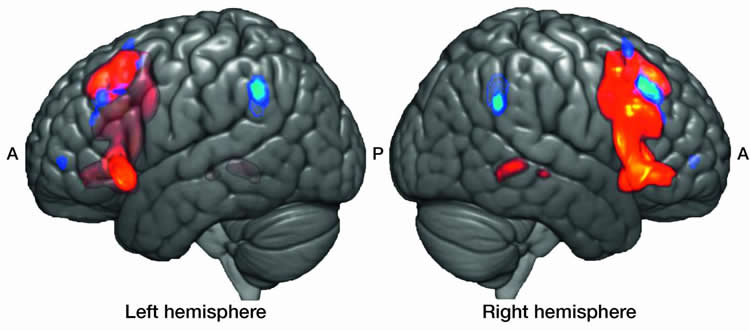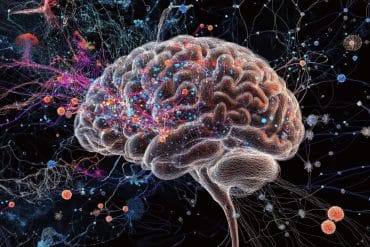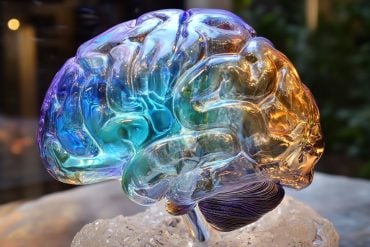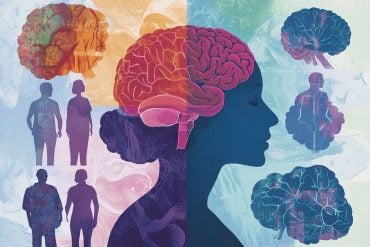Summary: Researchers reveal the right homologue of the Broca’s area plays a major role in the processing of music.
Source: Max Planck Institute.
Vincent Cheung, along with Angela Friederici, has been investigating non-local dependencies in music and trying to determine how the human brain processes them. In language and music, dependencies are conceptual threads that bind two things together. Non-local dependencies bind non-adjacent items. For example, in pop music, the second instance of a verse, following a chorus, would have a non-local dependency with the first instance of the verse. Experientially, it is clear to us that we are hearing a sequence that we have heard before. According to Cheung, composers use such devices to build up our expectations and elicit strong emotional responses to the music. But how does the brain recognize these patterns and what does this have to do with Paul Broca?
Paul Broca was a famous French physician and anatomist whose work with aphasic patients in the 1800s led to the discovery of Broca’s area; a small patch of the cerebral cortex just above the temple, specifically on the left side of the brain. Broca’s area is critical for speech production and for the processing of, you guessed it, dependencies in language. For example, Broca’s area is active when we detect violations to our well-learned grammatical rules. Surprisingly, despite Broca’s area being one of the most studied human brain regions, neuroscientists are still not exactly sure what the same region does, on the other side of the brain.
Theory suggests the right hemisphere equivalent, or homologue, of Broca’s area plays a similar role but for the processing of music instead of language. However, researchers have had difficulty demonstrating this, partly due to an inability to tease apart contributions of local and non-local dependencies to the structural hierarchy of the music. Enter Vincent Cheung’s alien music.
Of course, Mr. Cheung doesn’t really have authentic music from a distant world but that is how he referred to the music he developed for his study. He created a novel ‘genre’ of music described as, “randomly generated combinations of tone-triplets that were combined in a palindrome-like manner”. While that may not sound very pleasant, the short stimuli were actually quite pleasing to the ear. Vincent’s stimuli allowed the team to overcome the confounding hurtle of local dependencies. Importantly, there were sequences that conformed to a fabricated musical grammar as well as sequences that did not. This opened the door to determining where in the brain musical, non-local, dependencies are processed.
Musicians of varying expertise were invited to the laboratory to listen to Cheung’s short compositions. Their task was to guess whether individual sequences were grammatical, or not, and through their correct and incorrect responses, determine the underlying grammatical rule. Once the rule was learned participants were invited to perform the task in an MRI scanner, allowing the researchers to see which brain areas were recruited. The researchers hypothesized bilateral activation of the inferior frontal gyrus, the anatomical structure housing Broca’s area, during ungrammatical sequences compared to grammatical sequences. A clever manipulation also allowed them to dissociate between the processing of the non-local dependencies and the sheer demand on working memory. The complexity of the sequences was systematically varied such that more information would need to be held in memory in certain conditions.

The results, published in Scientific Reports this week, were consistent with their predictions, plus one surprise. The so-called Inferior frontal gyrus (IFG) was activated more during sequences which were ungrammatical than grammatical, although brain activity was more weighted towards the right hemisphere. That is, the brain became more active in the IFG during grammatical violations of the learned rule, but that tended to be more on the right than in Broca’s area on the left. Frontal and parietal regions with known roles in working memory were also found to underlie the complexity dimension of the task. Interestingly, the researchers found that the degree of functional connectivity, between brain regions involved in detecting grammatical violations and those related to working memory, predicted the performance accuracy of the participants in determining whether a sequence was grammatical or not. This suggests the task is accomplished through the integration of information in memory with some form of neural computation of the musical grammar in the right homologue of Broca’s area.
Vincent Cheung, first author of the underlying study, suggests the importance of the work lies in demonstrating that neurons capable of encoding non-local dependencies are not ‘supra-modal’. Rather, subpopulations seem to be geared for different stimulus types, now including music.
Source: Verena Müller – Max Planck Institute
Publisher: Organized by NeuroscienceNews.com.
Image Source: NeuroscienceNews.com image is credited to Nature Scientific Reports.
Original Research: Open access research in Scientific Reports.
doi:10.1038/s41598-018-22144-9
[cbtabs][cbtab title=”MLA”]Max Planck Institute “How the Brain Processes Music.” NeuroscienceNews. NeuroscienceNews, 13 March 2018.
<https://neurosciencenews.com/music-brain-processing-8625/>.[/cbtab][cbtab title=”APA”]Max Planck Institute (2018, March 13). How the Brain Processes Music. NeuroscienceNews. Retrieved March 13, 2018 from https://neurosciencenews.com/music-brain-processing-8625/[/cbtab][cbtab title=”Chicago”]Max Planck Institute “How the Brain Processes Music.” https://neurosciencenews.com/music-brain-processing-8625/ (accessed March 13, 2018).[/cbtab][/cbtabs]
Abstract
The right inferior frontal gyrus processes nested non-local dependencies in music
Complex auditory sequences known as music have often been described as hierarchically structured. This permits the existence of non-local dependencies, which relate elements of a sequence beyond their temporal sequential order. Previous studies in music have reported differential activity in the inferior frontal gyrus (IFG) when comparing regular and irregular chord-transitions based on theories in Western tonal harmony. However, it is unclear if the observed activity reflects the interpretation of hierarchical structure as the effects are confounded by local irregularity. Using functional magnetic resonance imaging (fMRI), we found that violations to non-local dependencies in nested sequences of three-tone musical motifs in musicians elicited increased activity in the right IFG. This is in contrast to similar studies in language which typically report the left IFG in processing grammatical syntax. Effects of increasing auditory working demands are moreover reflected by distributed activity in frontal and parietal regions. Our study therefore demonstrates the role of the right IFG in processing non-local dependencies in music, and suggests that hierarchical processing in different cognitive domains relies on similar mechanisms that are subserved by domain-selective neuronal subpopulations.






